Roles, Characteristics, and Theories in TESCO's Management
VerifiedAdded on 2023/01/13
|13
|3632
|91
Report
AI Summary
This report provides a comprehensive analysis of leadership and management practices within TESCO, a major British grocery retailer. The report begins by defining and comparing the roles and characteristics of leaders and managers, highlighting their distinct responsibilities and approaches. It then delves into the application of leadership and management in various situations, such as major product launches and conflict management scenarios. The report explores the roles of leaders, including transformational and democratic approaches, and the functions of managers, such as planning, organizing, and controlling. The analysis considers specific situations, detailing how leaders and managers should adapt their strategies to achieve organizational goals. The report uses TESCO as a case study to provide practical examples and insights into effective leadership and management. The report also includes details on the application of leadership and management theories and approaches, providing a well-rounded understanding of the subject matter.
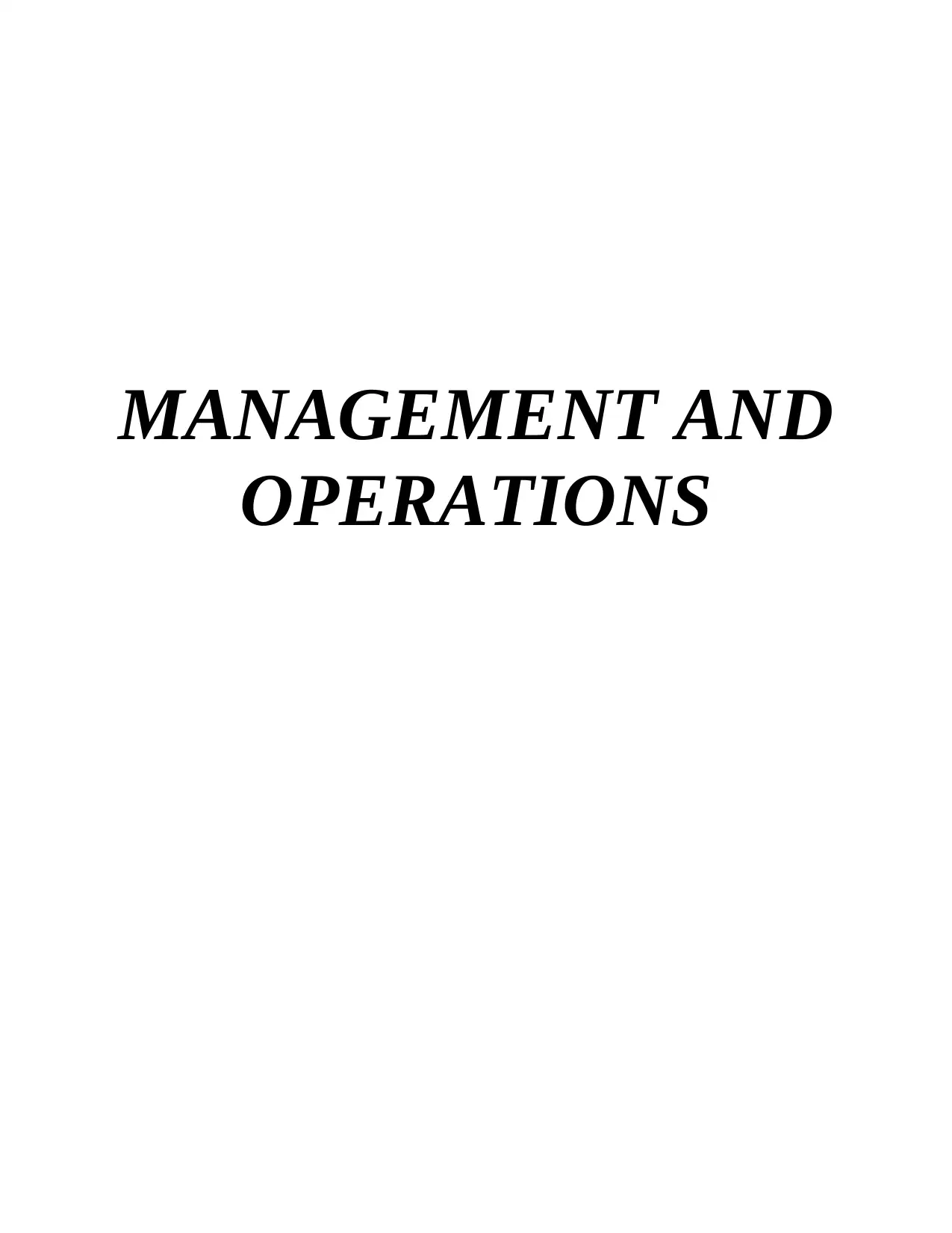
MANAGEMENT AND
OPERATIONS
OPERATIONS
Paraphrase This Document
Need a fresh take? Get an instant paraphrase of this document with our AI Paraphraser
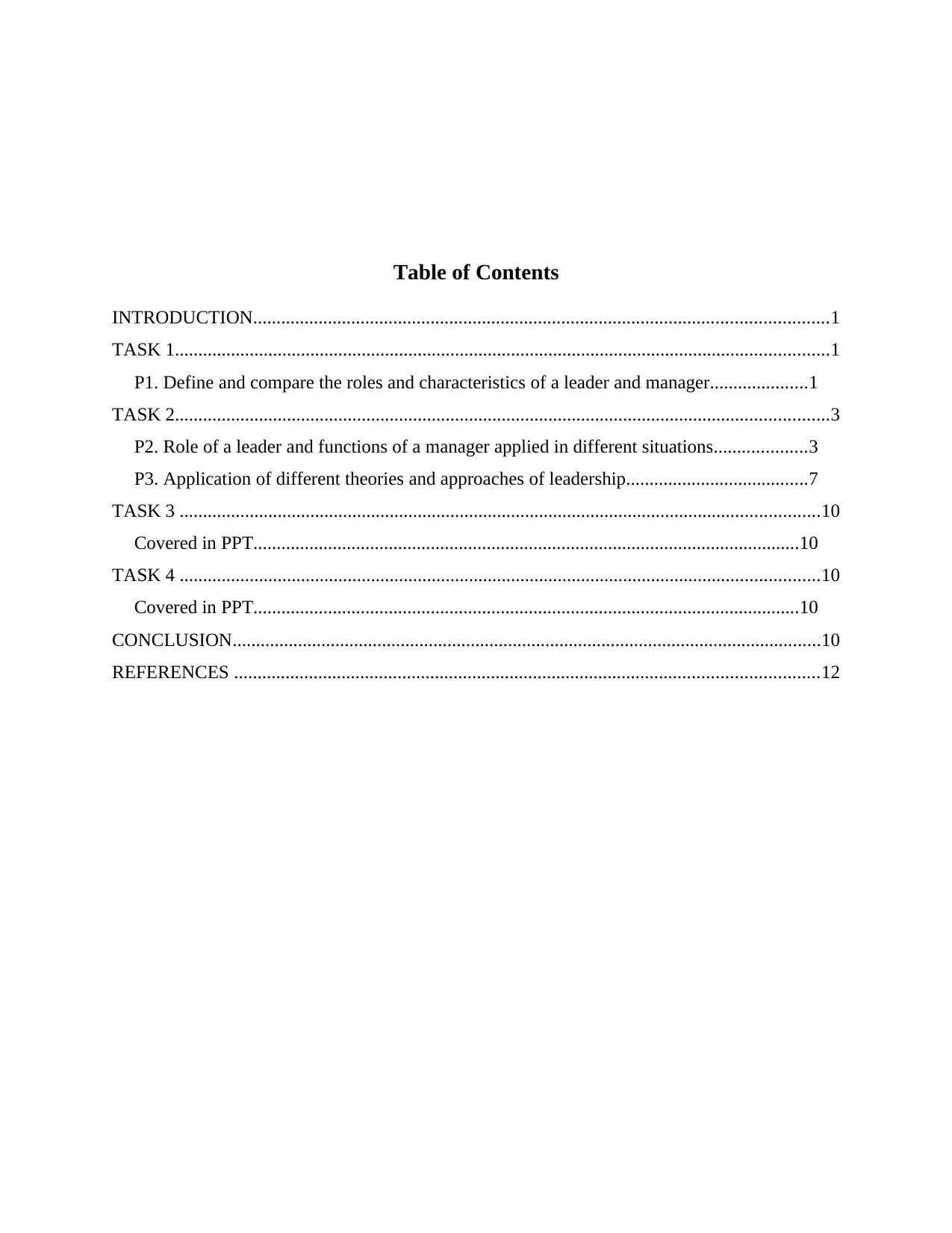
Table of Contents
INTRODUCTION...........................................................................................................................1
TASK 1............................................................................................................................................1
P1. Define and compare the roles and characteristics of a leader and manager.....................1
TASK 2............................................................................................................................................3
P2. Role of a leader and functions of a manager applied in different situations....................3
P3. Application of different theories and approaches of leadership.......................................7
TASK 3 .........................................................................................................................................10
Covered in PPT.....................................................................................................................10
TASK 4 .........................................................................................................................................10
Covered in PPT.....................................................................................................................10
CONCLUSION..............................................................................................................................10
REFERENCES .............................................................................................................................12
INTRODUCTION...........................................................................................................................1
TASK 1............................................................................................................................................1
P1. Define and compare the roles and characteristics of a leader and manager.....................1
TASK 2............................................................................................................................................3
P2. Role of a leader and functions of a manager applied in different situations....................3
P3. Application of different theories and approaches of leadership.......................................7
TASK 3 .........................................................................................................................................10
Covered in PPT.....................................................................................................................10
TASK 4 .........................................................................................................................................10
Covered in PPT.....................................................................................................................10
CONCLUSION..............................................................................................................................10
REFERENCES .............................................................................................................................12
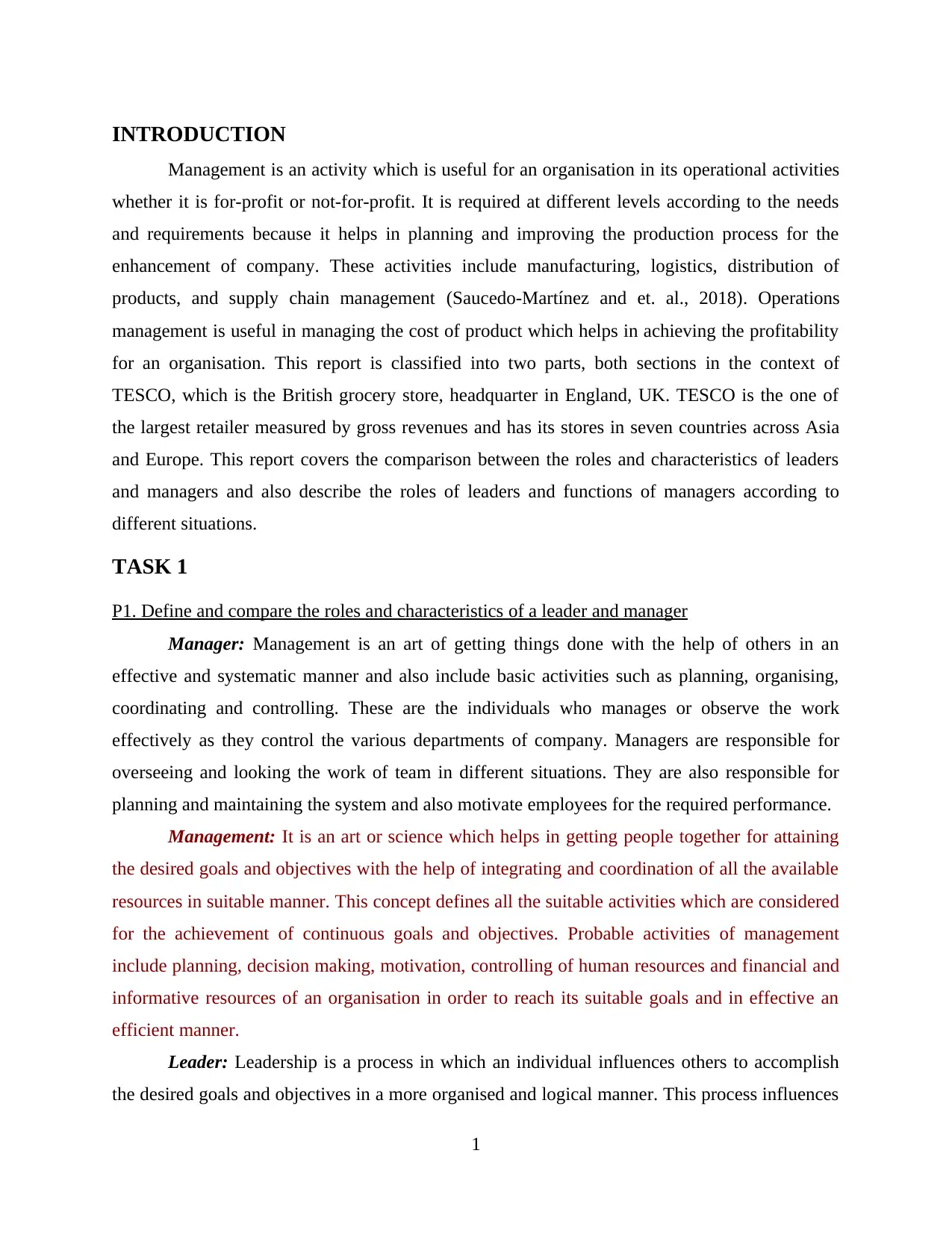
INTRODUCTION
Management is an activity which is useful for an organisation in its operational activities
whether it is for-profit or not-for-profit. It is required at different levels according to the needs
and requirements because it helps in planning and improving the production process for the
enhancement of company. These activities include manufacturing, logistics, distribution of
products, and supply chain management (Saucedo-Martínez and et. al., 2018). Operations
management is useful in managing the cost of product which helps in achieving the profitability
for an organisation. This report is classified into two parts, both sections in the context of
TESCO, which is the British grocery store, headquarter in England, UK. TESCO is the one of
the largest retailer measured by gross revenues and has its stores in seven countries across Asia
and Europe. This report covers the comparison between the roles and characteristics of leaders
and managers and also describe the roles of leaders and functions of managers according to
different situations.
TASK 1
P1. Define and compare the roles and characteristics of a leader and manager
Manager: Management is an art of getting things done with the help of others in an
effective and systematic manner and also include basic activities such as planning, organising,
coordinating and controlling. These are the individuals who manages or observe the work
effectively as they control the various departments of company. Managers are responsible for
overseeing and looking the work of team in different situations. They are also responsible for
planning and maintaining the system and also motivate employees for the required performance.
Management: It is an art or science which helps in getting people together for attaining
the desired goals and objectives with the help of integrating and coordination of all the available
resources in suitable manner. This concept defines all the suitable activities which are considered
for the achievement of continuous goals and objectives. Probable activities of management
include planning, decision making, motivation, controlling of human resources and financial and
informative resources of an organisation in order to reach its suitable goals and in effective an
efficient manner.
Leader: Leadership is a process in which an individual influences others to accomplish
the desired goals and objectives in a more organised and logical manner. This process influences
1
Management is an activity which is useful for an organisation in its operational activities
whether it is for-profit or not-for-profit. It is required at different levels according to the needs
and requirements because it helps in planning and improving the production process for the
enhancement of company. These activities include manufacturing, logistics, distribution of
products, and supply chain management (Saucedo-Martínez and et. al., 2018). Operations
management is useful in managing the cost of product which helps in achieving the profitability
for an organisation. This report is classified into two parts, both sections in the context of
TESCO, which is the British grocery store, headquarter in England, UK. TESCO is the one of
the largest retailer measured by gross revenues and has its stores in seven countries across Asia
and Europe. This report covers the comparison between the roles and characteristics of leaders
and managers and also describe the roles of leaders and functions of managers according to
different situations.
TASK 1
P1. Define and compare the roles and characteristics of a leader and manager
Manager: Management is an art of getting things done with the help of others in an
effective and systematic manner and also include basic activities such as planning, organising,
coordinating and controlling. These are the individuals who manages or observe the work
effectively as they control the various departments of company. Managers are responsible for
overseeing and looking the work of team in different situations. They are also responsible for
planning and maintaining the system and also motivate employees for the required performance.
Management: It is an art or science which helps in getting people together for attaining
the desired goals and objectives with the help of integrating and coordination of all the available
resources in suitable manner. This concept defines all the suitable activities which are considered
for the achievement of continuous goals and objectives. Probable activities of management
include planning, decision making, motivation, controlling of human resources and financial and
informative resources of an organisation in order to reach its suitable goals and in effective an
efficient manner.
Leader: Leadership is a process in which an individual influences others to accomplish
the desired goals and objectives in a more organised and logical manner. This process influences
1
⊘ This is a preview!⊘
Do you want full access?
Subscribe today to unlock all pages.

Trusted by 1+ million students worldwide
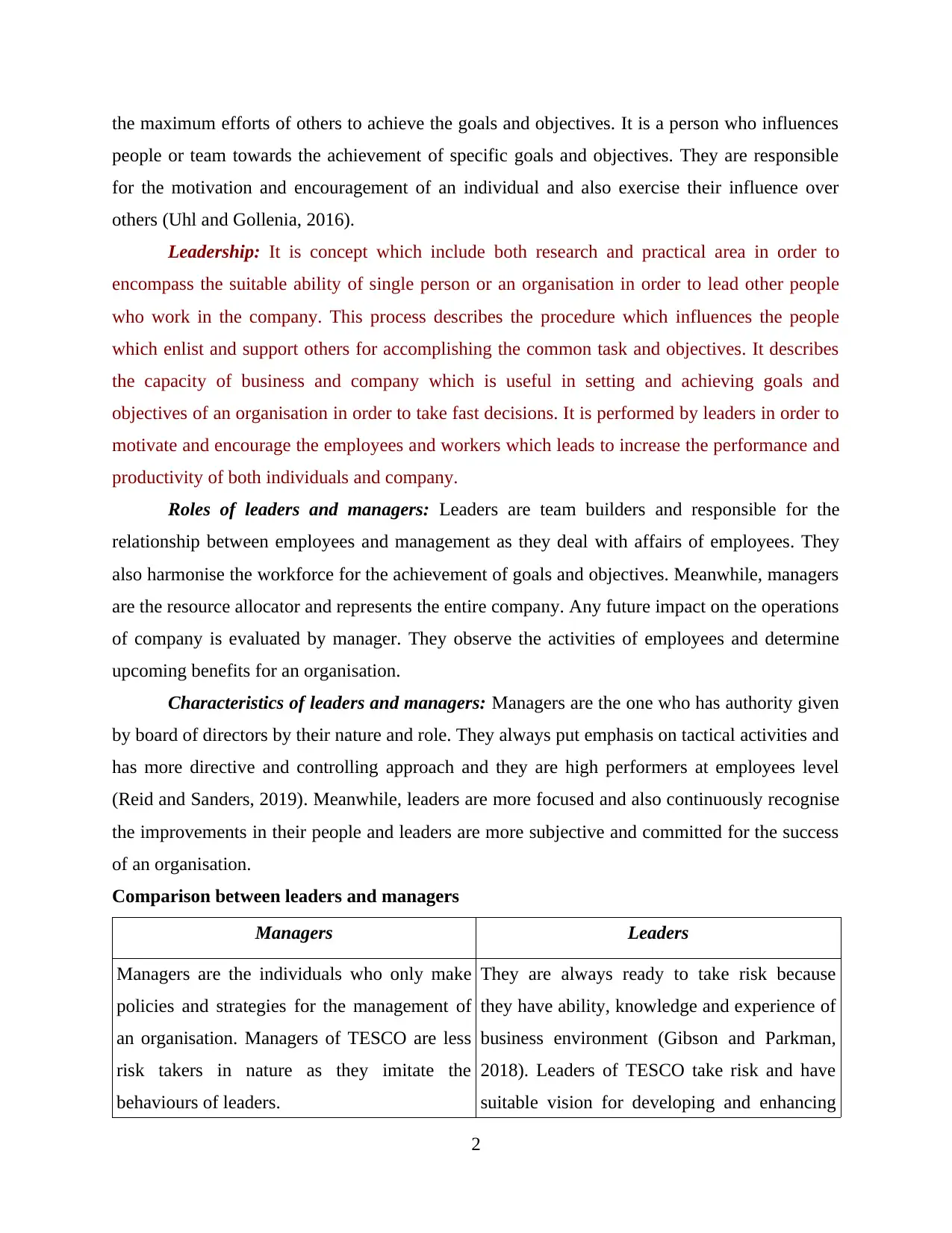
the maximum efforts of others to achieve the goals and objectives. It is a person who influences
people or team towards the achievement of specific goals and objectives. They are responsible
for the motivation and encouragement of an individual and also exercise their influence over
others (Uhl and Gollenia, 2016).
Leadership: It is concept which include both research and practical area in order to
encompass the suitable ability of single person or an organisation in order to lead other people
who work in the company. This process describes the procedure which influences the people
which enlist and support others for accomplishing the common task and objectives. It describes
the capacity of business and company which is useful in setting and achieving goals and
objectives of an organisation in order to take fast decisions. It is performed by leaders in order to
motivate and encourage the employees and workers which leads to increase the performance and
productivity of both individuals and company.
Roles of leaders and managers: Leaders are team builders and responsible for the
relationship between employees and management as they deal with affairs of employees. They
also harmonise the workforce for the achievement of goals and objectives. Meanwhile, managers
are the resource allocator and represents the entire company. Any future impact on the operations
of company is evaluated by manager. They observe the activities of employees and determine
upcoming benefits for an organisation.
Characteristics of leaders and managers: Managers are the one who has authority given
by board of directors by their nature and role. They always put emphasis on tactical activities and
has more directive and controlling approach and they are high performers at employees level
(Reid and Sanders, 2019). Meanwhile, leaders are more focused and also continuously recognise
the improvements in their people and leaders are more subjective and committed for the success
of an organisation.
Comparison between leaders and managers
Managers Leaders
Managers are the individuals who only make
policies and strategies for the management of
an organisation. Managers of TESCO are less
risk takers in nature as they imitate the
behaviours of leaders.
They are always ready to take risk because
they have ability, knowledge and experience of
business environment (Gibson and Parkman,
2018). Leaders of TESCO take risk and have
suitable vision for developing and enhancing
2
people or team towards the achievement of specific goals and objectives. They are responsible
for the motivation and encouragement of an individual and also exercise their influence over
others (Uhl and Gollenia, 2016).
Leadership: It is concept which include both research and practical area in order to
encompass the suitable ability of single person or an organisation in order to lead other people
who work in the company. This process describes the procedure which influences the people
which enlist and support others for accomplishing the common task and objectives. It describes
the capacity of business and company which is useful in setting and achieving goals and
objectives of an organisation in order to take fast decisions. It is performed by leaders in order to
motivate and encourage the employees and workers which leads to increase the performance and
productivity of both individuals and company.
Roles of leaders and managers: Leaders are team builders and responsible for the
relationship between employees and management as they deal with affairs of employees. They
also harmonise the workforce for the achievement of goals and objectives. Meanwhile, managers
are the resource allocator and represents the entire company. Any future impact on the operations
of company is evaluated by manager. They observe the activities of employees and determine
upcoming benefits for an organisation.
Characteristics of leaders and managers: Managers are the one who has authority given
by board of directors by their nature and role. They always put emphasis on tactical activities and
has more directive and controlling approach and they are high performers at employees level
(Reid and Sanders, 2019). Meanwhile, leaders are more focused and also continuously recognise
the improvements in their people and leaders are more subjective and committed for the success
of an organisation.
Comparison between leaders and managers
Managers Leaders
Managers are the individuals who only make
policies and strategies for the management of
an organisation. Managers of TESCO are less
risk takers in nature as they imitate the
behaviours of leaders.
They are always ready to take risk because
they have ability, knowledge and experience of
business environment (Gibson and Parkman,
2018). Leaders of TESCO take risk and have
suitable vision for developing and enhancing
2
Paraphrase This Document
Need a fresh take? Get an instant paraphrase of this document with our AI Paraphraser
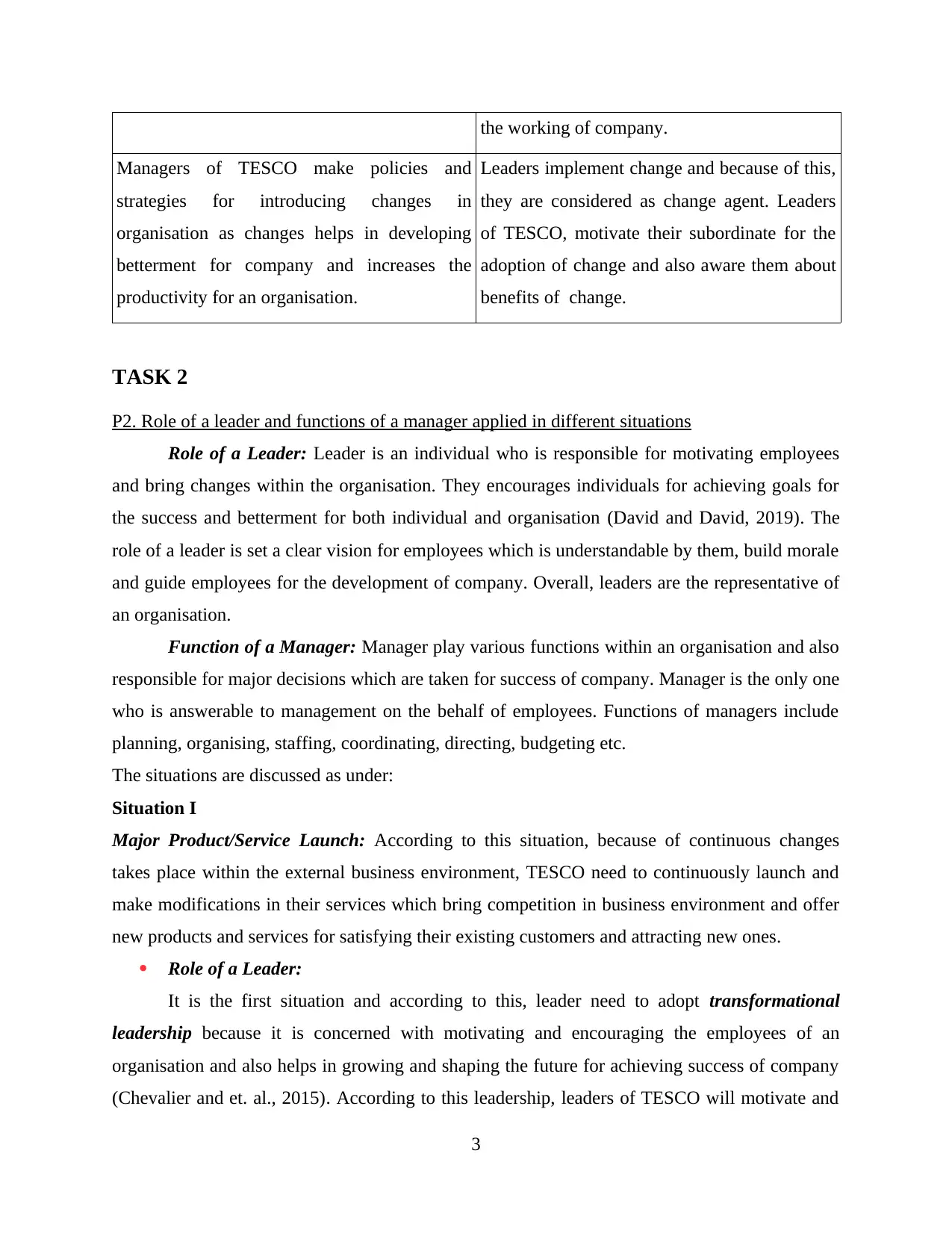
the working of company.
Managers of TESCO make policies and
strategies for introducing changes in
organisation as changes helps in developing
betterment for company and increases the
productivity for an organisation.
Leaders implement change and because of this,
they are considered as change agent. Leaders
of TESCO, motivate their subordinate for the
adoption of change and also aware them about
benefits of change.
TASK 2
P2. Role of a leader and functions of a manager applied in different situations
Role of a Leader: Leader is an individual who is responsible for motivating employees
and bring changes within the organisation. They encourages individuals for achieving goals for
the success and betterment for both individual and organisation (David and David, 2019). The
role of a leader is set a clear vision for employees which is understandable by them, build morale
and guide employees for the development of company. Overall, leaders are the representative of
an organisation.
Function of a Manager: Manager play various functions within an organisation and also
responsible for major decisions which are taken for success of company. Manager is the only one
who is answerable to management on the behalf of employees. Functions of managers include
planning, organising, staffing, coordinating, directing, budgeting etc.
The situations are discussed as under:
Situation I
Major Product/Service Launch: According to this situation, because of continuous changes
takes place within the external business environment, TESCO need to continuously launch and
make modifications in their services which bring competition in business environment and offer
new products and services for satisfying their existing customers and attracting new ones.
Role of a Leader:
It is the first situation and according to this, leader need to adopt transformational
leadership because it is concerned with motivating and encouraging the employees of an
organisation and also helps in growing and shaping the future for achieving success of company
(Chevalier and et. al., 2015). According to this leadership, leaders of TESCO will motivate and
3
Managers of TESCO make policies and
strategies for introducing changes in
organisation as changes helps in developing
betterment for company and increases the
productivity for an organisation.
Leaders implement change and because of this,
they are considered as change agent. Leaders
of TESCO, motivate their subordinate for the
adoption of change and also aware them about
benefits of change.
TASK 2
P2. Role of a leader and functions of a manager applied in different situations
Role of a Leader: Leader is an individual who is responsible for motivating employees
and bring changes within the organisation. They encourages individuals for achieving goals for
the success and betterment for both individual and organisation (David and David, 2019). The
role of a leader is set a clear vision for employees which is understandable by them, build morale
and guide employees for the development of company. Overall, leaders are the representative of
an organisation.
Function of a Manager: Manager play various functions within an organisation and also
responsible for major decisions which are taken for success of company. Manager is the only one
who is answerable to management on the behalf of employees. Functions of managers include
planning, organising, staffing, coordinating, directing, budgeting etc.
The situations are discussed as under:
Situation I
Major Product/Service Launch: According to this situation, because of continuous changes
takes place within the external business environment, TESCO need to continuously launch and
make modifications in their services which bring competition in business environment and offer
new products and services for satisfying their existing customers and attracting new ones.
Role of a Leader:
It is the first situation and according to this, leader need to adopt transformational
leadership because it is concerned with motivating and encouraging the employees of an
organisation and also helps in growing and shaping the future for achieving success of company
(Chevalier and et. al., 2015). According to this leadership, leaders of TESCO will motivate and
3
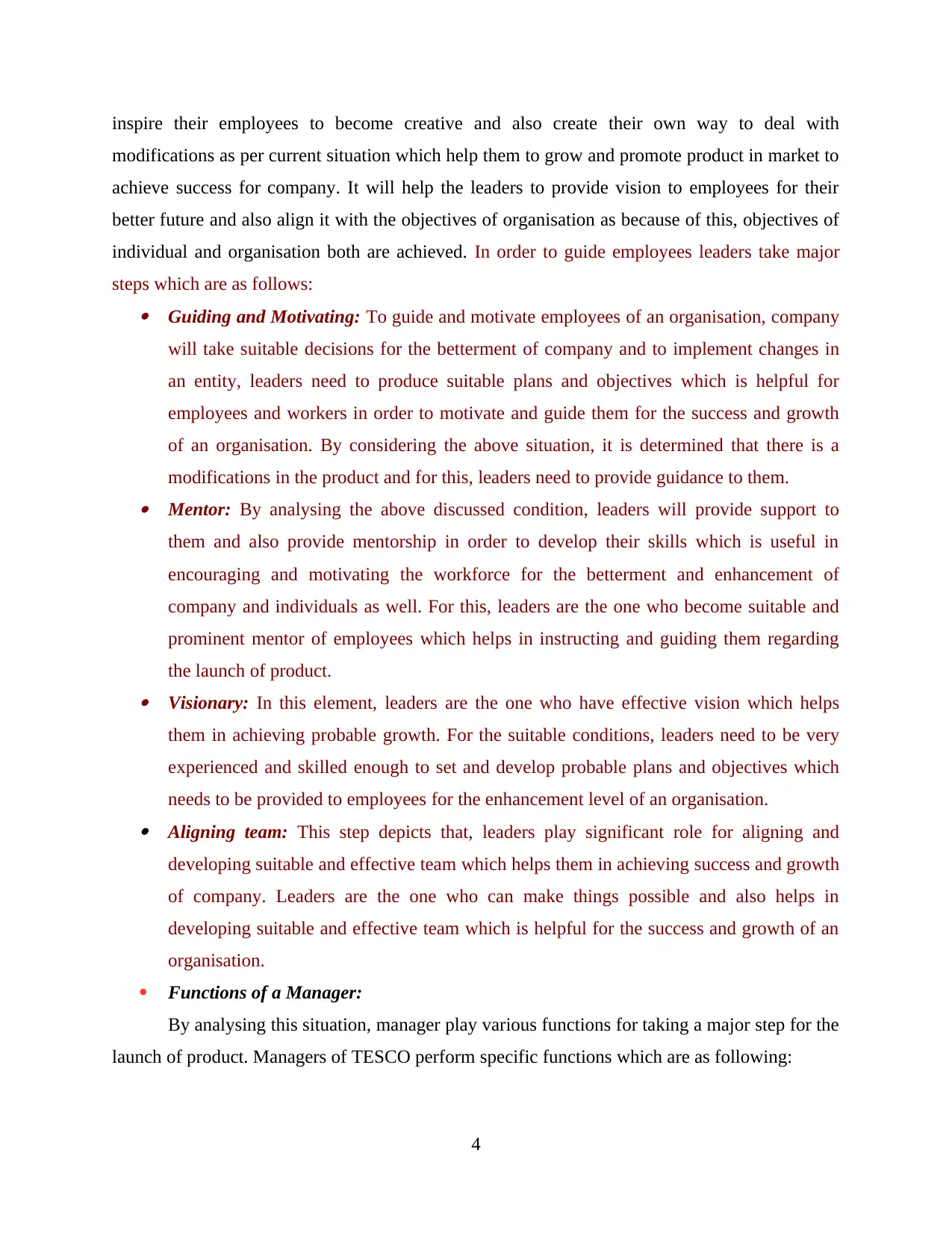
inspire their employees to become creative and also create their own way to deal with
modifications as per current situation which help them to grow and promote product in market to
achieve success for company. It will help the leaders to provide vision to employees for their
better future and also align it with the objectives of organisation as because of this, objectives of
individual and organisation both are achieved. In order to guide employees leaders take major
steps which are as follows: Guiding and Motivating: To guide and motivate employees of an organisation, company
will take suitable decisions for the betterment of company and to implement changes in
an entity, leaders need to produce suitable plans and objectives which is helpful for
employees and workers in order to motivate and guide them for the success and growth
of an organisation. By considering the above situation, it is determined that there is a
modifications in the product and for this, leaders need to provide guidance to them. Mentor: By analysing the above discussed condition, leaders will provide support to
them and also provide mentorship in order to develop their skills which is useful in
encouraging and motivating the workforce for the betterment and enhancement of
company and individuals as well. For this, leaders are the one who become suitable and
prominent mentor of employees which helps in instructing and guiding them regarding
the launch of product. Visionary: In this element, leaders are the one who have effective vision which helps
them in achieving probable growth. For the suitable conditions, leaders need to be very
experienced and skilled enough to set and develop probable plans and objectives which
needs to be provided to employees for the enhancement level of an organisation. Aligning team: This step depicts that, leaders play significant role for aligning and
developing suitable and effective team which helps them in achieving success and growth
of company. Leaders are the one who can make things possible and also helps in
developing suitable and effective team which is helpful for the success and growth of an
organisation.
Functions of a Manager:
By analysing this situation, manager play various functions for taking a major step for the
launch of product. Managers of TESCO perform specific functions which are as following:
4
modifications as per current situation which help them to grow and promote product in market to
achieve success for company. It will help the leaders to provide vision to employees for their
better future and also align it with the objectives of organisation as because of this, objectives of
individual and organisation both are achieved. In order to guide employees leaders take major
steps which are as follows: Guiding and Motivating: To guide and motivate employees of an organisation, company
will take suitable decisions for the betterment of company and to implement changes in
an entity, leaders need to produce suitable plans and objectives which is helpful for
employees and workers in order to motivate and guide them for the success and growth
of an organisation. By considering the above situation, it is determined that there is a
modifications in the product and for this, leaders need to provide guidance to them. Mentor: By analysing the above discussed condition, leaders will provide support to
them and also provide mentorship in order to develop their skills which is useful in
encouraging and motivating the workforce for the betterment and enhancement of
company and individuals as well. For this, leaders are the one who become suitable and
prominent mentor of employees which helps in instructing and guiding them regarding
the launch of product. Visionary: In this element, leaders are the one who have effective vision which helps
them in achieving probable growth. For the suitable conditions, leaders need to be very
experienced and skilled enough to set and develop probable plans and objectives which
needs to be provided to employees for the enhancement level of an organisation. Aligning team: This step depicts that, leaders play significant role for aligning and
developing suitable and effective team which helps them in achieving success and growth
of company. Leaders are the one who can make things possible and also helps in
developing suitable and effective team which is helpful for the success and growth of an
organisation.
Functions of a Manager:
By analysing this situation, manager play various functions for taking a major step for the
launch of product. Managers of TESCO perform specific functions which are as following:
4
⊘ This is a preview!⊘
Do you want full access?
Subscribe today to unlock all pages.

Trusted by 1+ million students worldwide
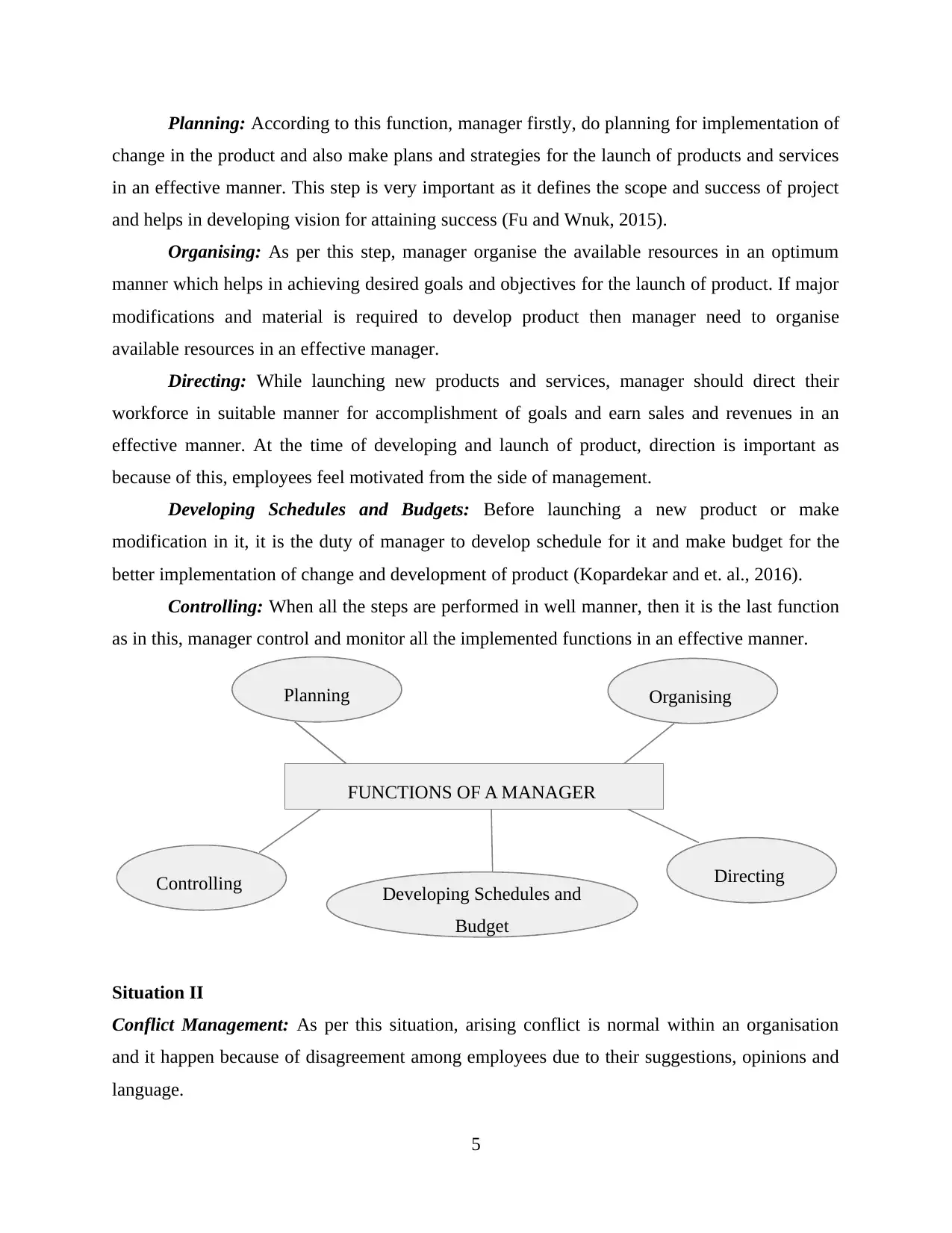
Planning: According to this function, manager firstly, do planning for implementation of
change in the product and also make plans and strategies for the launch of products and services
in an effective manner. This step is very important as it defines the scope and success of project
and helps in developing vision for attaining success (Fu and Wnuk, 2015).
Organising: As per this step, manager organise the available resources in an optimum
manner which helps in achieving desired goals and objectives for the launch of product. If major
modifications and material is required to develop product then manager need to organise
available resources in an effective manager.
Directing: While launching new products and services, manager should direct their
workforce in suitable manner for accomplishment of goals and earn sales and revenues in an
effective manner. At the time of developing and launch of product, direction is important as
because of this, employees feel motivated from the side of management.
Developing Schedules and Budgets: Before launching a new product or make
modification in it, it is the duty of manager to develop schedule for it and make budget for the
better implementation of change and development of product (Kopardekar and et. al., 2016).
Controlling: When all the steps are performed in well manner, then it is the last function
as in this, manager control and monitor all the implemented functions in an effective manner.
Situation II
Conflict Management: As per this situation, arising conflict is normal within an organisation
and it happen because of disagreement among employees due to their suggestions, opinions and
language.
5
FUNCTIONS OF A MANAGER
Controlling
Planning Organising
Directing
Developing Schedules and
Budget
change in the product and also make plans and strategies for the launch of products and services
in an effective manner. This step is very important as it defines the scope and success of project
and helps in developing vision for attaining success (Fu and Wnuk, 2015).
Organising: As per this step, manager organise the available resources in an optimum
manner which helps in achieving desired goals and objectives for the launch of product. If major
modifications and material is required to develop product then manager need to organise
available resources in an effective manager.
Directing: While launching new products and services, manager should direct their
workforce in suitable manner for accomplishment of goals and earn sales and revenues in an
effective manner. At the time of developing and launch of product, direction is important as
because of this, employees feel motivated from the side of management.
Developing Schedules and Budgets: Before launching a new product or make
modification in it, it is the duty of manager to develop schedule for it and make budget for the
better implementation of change and development of product (Kopardekar and et. al., 2016).
Controlling: When all the steps are performed in well manner, then it is the last function
as in this, manager control and monitor all the implemented functions in an effective manner.
Situation II
Conflict Management: As per this situation, arising conflict is normal within an organisation
and it happen because of disagreement among employees due to their suggestions, opinions and
language.
5
FUNCTIONS OF A MANAGER
Controlling
Planning Organising
Directing
Developing Schedules and
Budget
Paraphrase This Document
Need a fresh take? Get an instant paraphrase of this document with our AI Paraphraser
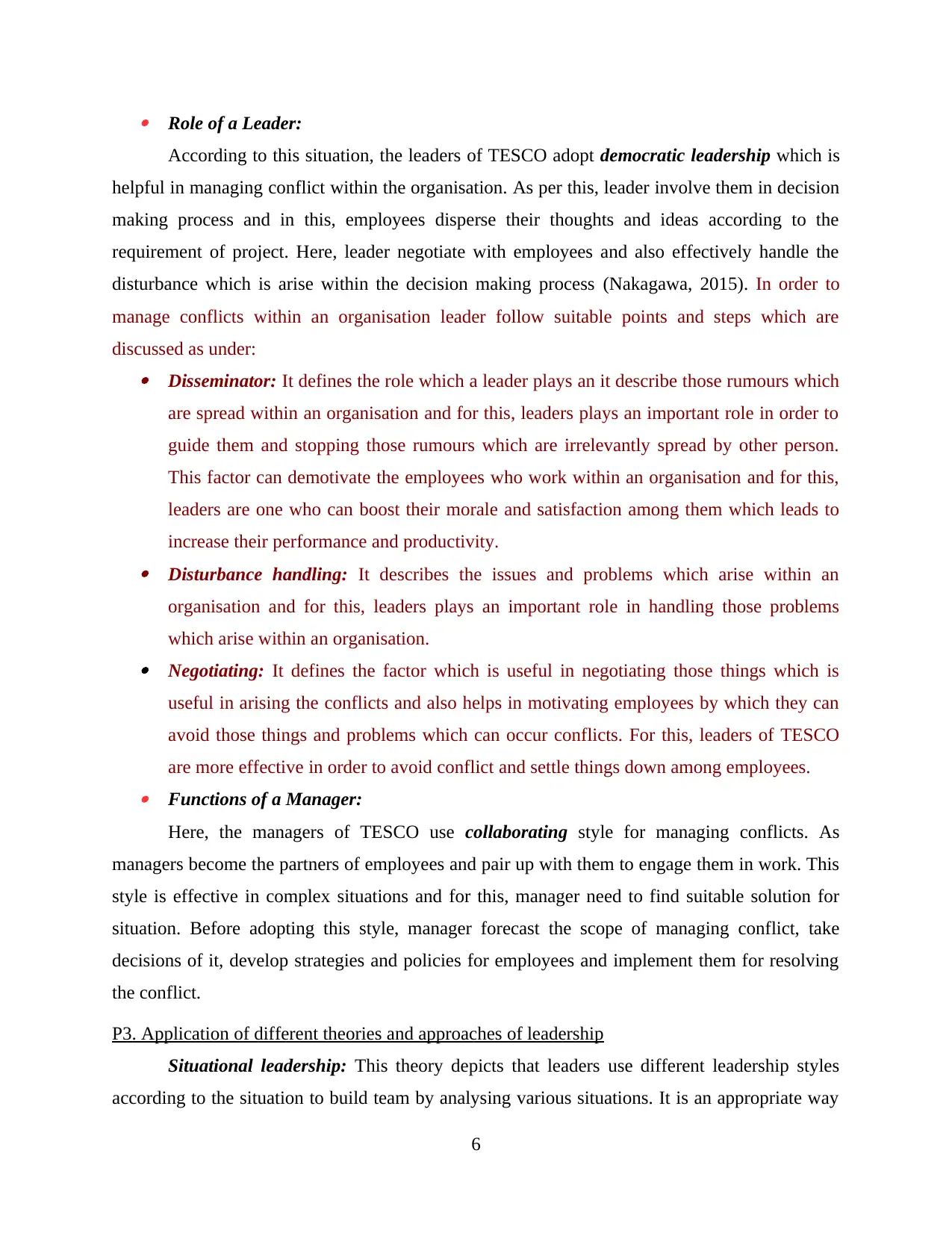
Role of a Leader:
According to this situation, the leaders of TESCO adopt democratic leadership which is
helpful in managing conflict within the organisation. As per this, leader involve them in decision
making process and in this, employees disperse their thoughts and ideas according to the
requirement of project. Here, leader negotiate with employees and also effectively handle the
disturbance which is arise within the decision making process (Nakagawa, 2015). In order to
manage conflicts within an organisation leader follow suitable points and steps which are
discussed as under: Disseminator: It defines the role which a leader plays an it describe those rumours which
are spread within an organisation and for this, leaders plays an important role in order to
guide them and stopping those rumours which are irrelevantly spread by other person.
This factor can demotivate the employees who work within an organisation and for this,
leaders are one who can boost their morale and satisfaction among them which leads to
increase their performance and productivity. Disturbance handling: It describes the issues and problems which arise within an
organisation and for this, leaders plays an important role in handling those problems
which arise within an organisation. Negotiating: It defines the factor which is useful in negotiating those things which is
useful in arising the conflicts and also helps in motivating employees by which they can
avoid those things and problems which can occur conflicts. For this, leaders of TESCO
are more effective in order to avoid conflict and settle things down among employees. Functions of a Manager:
Here, the managers of TESCO use collaborating style for managing conflicts. As
managers become the partners of employees and pair up with them to engage them in work. This
style is effective in complex situations and for this, manager need to find suitable solution for
situation. Before adopting this style, manager forecast the scope of managing conflict, take
decisions of it, develop strategies and policies for employees and implement them for resolving
the conflict.
P3. Application of different theories and approaches of leadership
Situational leadership: This theory depicts that leaders use different leadership styles
according to the situation to build team by analysing various situations. It is an appropriate way
6
According to this situation, the leaders of TESCO adopt democratic leadership which is
helpful in managing conflict within the organisation. As per this, leader involve them in decision
making process and in this, employees disperse their thoughts and ideas according to the
requirement of project. Here, leader negotiate with employees and also effectively handle the
disturbance which is arise within the decision making process (Nakagawa, 2015). In order to
manage conflicts within an organisation leader follow suitable points and steps which are
discussed as under: Disseminator: It defines the role which a leader plays an it describe those rumours which
are spread within an organisation and for this, leaders plays an important role in order to
guide them and stopping those rumours which are irrelevantly spread by other person.
This factor can demotivate the employees who work within an organisation and for this,
leaders are one who can boost their morale and satisfaction among them which leads to
increase their performance and productivity. Disturbance handling: It describes the issues and problems which arise within an
organisation and for this, leaders plays an important role in handling those problems
which arise within an organisation. Negotiating: It defines the factor which is useful in negotiating those things which is
useful in arising the conflicts and also helps in motivating employees by which they can
avoid those things and problems which can occur conflicts. For this, leaders of TESCO
are more effective in order to avoid conflict and settle things down among employees. Functions of a Manager:
Here, the managers of TESCO use collaborating style for managing conflicts. As
managers become the partners of employees and pair up with them to engage them in work. This
style is effective in complex situations and for this, manager need to find suitable solution for
situation. Before adopting this style, manager forecast the scope of managing conflict, take
decisions of it, develop strategies and policies for employees and implement them for resolving
the conflict.
P3. Application of different theories and approaches of leadership
Situational leadership: This theory depicts that leaders use different leadership styles
according to the situation to build team by analysing various situations. It is an appropriate way
6
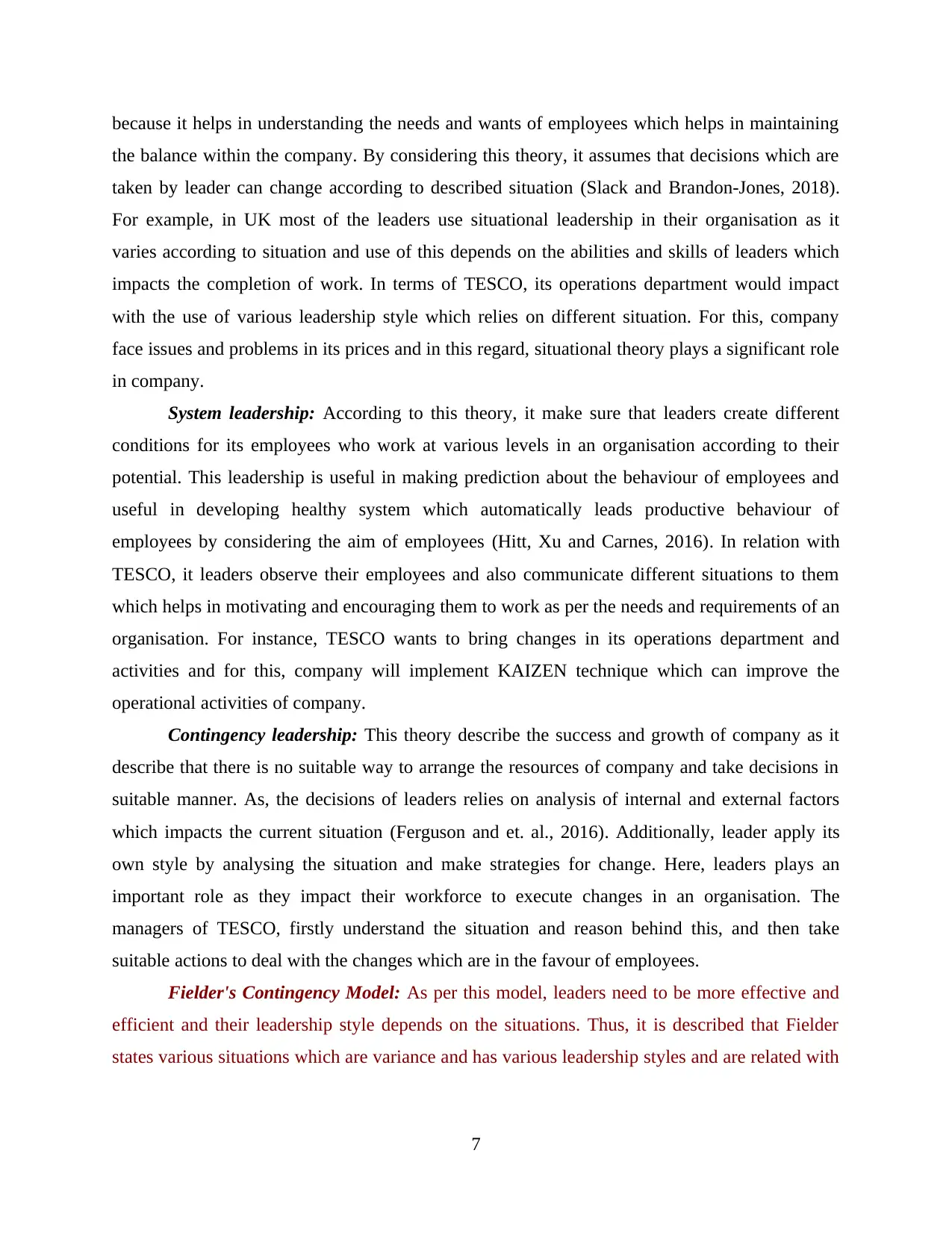
because it helps in understanding the needs and wants of employees which helps in maintaining
the balance within the company. By considering this theory, it assumes that decisions which are
taken by leader can change according to described situation (Slack and Brandon-Jones, 2018).
For example, in UK most of the leaders use situational leadership in their organisation as it
varies according to situation and use of this depends on the abilities and skills of leaders which
impacts the completion of work. In terms of TESCO, its operations department would impact
with the use of various leadership style which relies on different situation. For this, company
face issues and problems in its prices and in this regard, situational theory plays a significant role
in company.
System leadership: According to this theory, it make sure that leaders create different
conditions for its employees who work at various levels in an organisation according to their
potential. This leadership is useful in making prediction about the behaviour of employees and
useful in developing healthy system which automatically leads productive behaviour of
employees by considering the aim of employees (Hitt, Xu and Carnes, 2016). In relation with
TESCO, it leaders observe their employees and also communicate different situations to them
which helps in motivating and encouraging them to work as per the needs and requirements of an
organisation. For instance, TESCO wants to bring changes in its operations department and
activities and for this, company will implement KAIZEN technique which can improve the
operational activities of company.
Contingency leadership: This theory describe the success and growth of company as it
describe that there is no suitable way to arrange the resources of company and take decisions in
suitable manner. As, the decisions of leaders relies on analysis of internal and external factors
which impacts the current situation (Ferguson and et. al., 2016). Additionally, leader apply its
own style by analysing the situation and make strategies for change. Here, leaders plays an
important role as they impact their workforce to execute changes in an organisation. The
managers of TESCO, firstly understand the situation and reason behind this, and then take
suitable actions to deal with the changes which are in the favour of employees.
Fielder's Contingency Model: As per this model, leaders need to be more effective and
efficient and their leadership style depends on the situations. Thus, it is described that Fielder
states various situations which are variance and has various leadership styles and are related with
7
the balance within the company. By considering this theory, it assumes that decisions which are
taken by leader can change according to described situation (Slack and Brandon-Jones, 2018).
For example, in UK most of the leaders use situational leadership in their organisation as it
varies according to situation and use of this depends on the abilities and skills of leaders which
impacts the completion of work. In terms of TESCO, its operations department would impact
with the use of various leadership style which relies on different situation. For this, company
face issues and problems in its prices and in this regard, situational theory plays a significant role
in company.
System leadership: According to this theory, it make sure that leaders create different
conditions for its employees who work at various levels in an organisation according to their
potential. This leadership is useful in making prediction about the behaviour of employees and
useful in developing healthy system which automatically leads productive behaviour of
employees by considering the aim of employees (Hitt, Xu and Carnes, 2016). In relation with
TESCO, it leaders observe their employees and also communicate different situations to them
which helps in motivating and encouraging them to work as per the needs and requirements of an
organisation. For instance, TESCO wants to bring changes in its operations department and
activities and for this, company will implement KAIZEN technique which can improve the
operational activities of company.
Contingency leadership: This theory describe the success and growth of company as it
describe that there is no suitable way to arrange the resources of company and take decisions in
suitable manner. As, the decisions of leaders relies on analysis of internal and external factors
which impacts the current situation (Ferguson and et. al., 2016). Additionally, leader apply its
own style by analysing the situation and make strategies for change. Here, leaders plays an
important role as they impact their workforce to execute changes in an organisation. The
managers of TESCO, firstly understand the situation and reason behind this, and then take
suitable actions to deal with the changes which are in the favour of employees.
Fielder's Contingency Model: As per this model, leaders need to be more effective and
efficient and their leadership style depends on the situations. Thus, it is described that Fielder
states various situations which are variance and has various leadership styles and are related with
7
⊘ This is a preview!⊘
Do you want full access?
Subscribe today to unlock all pages.

Trusted by 1+ million students worldwide
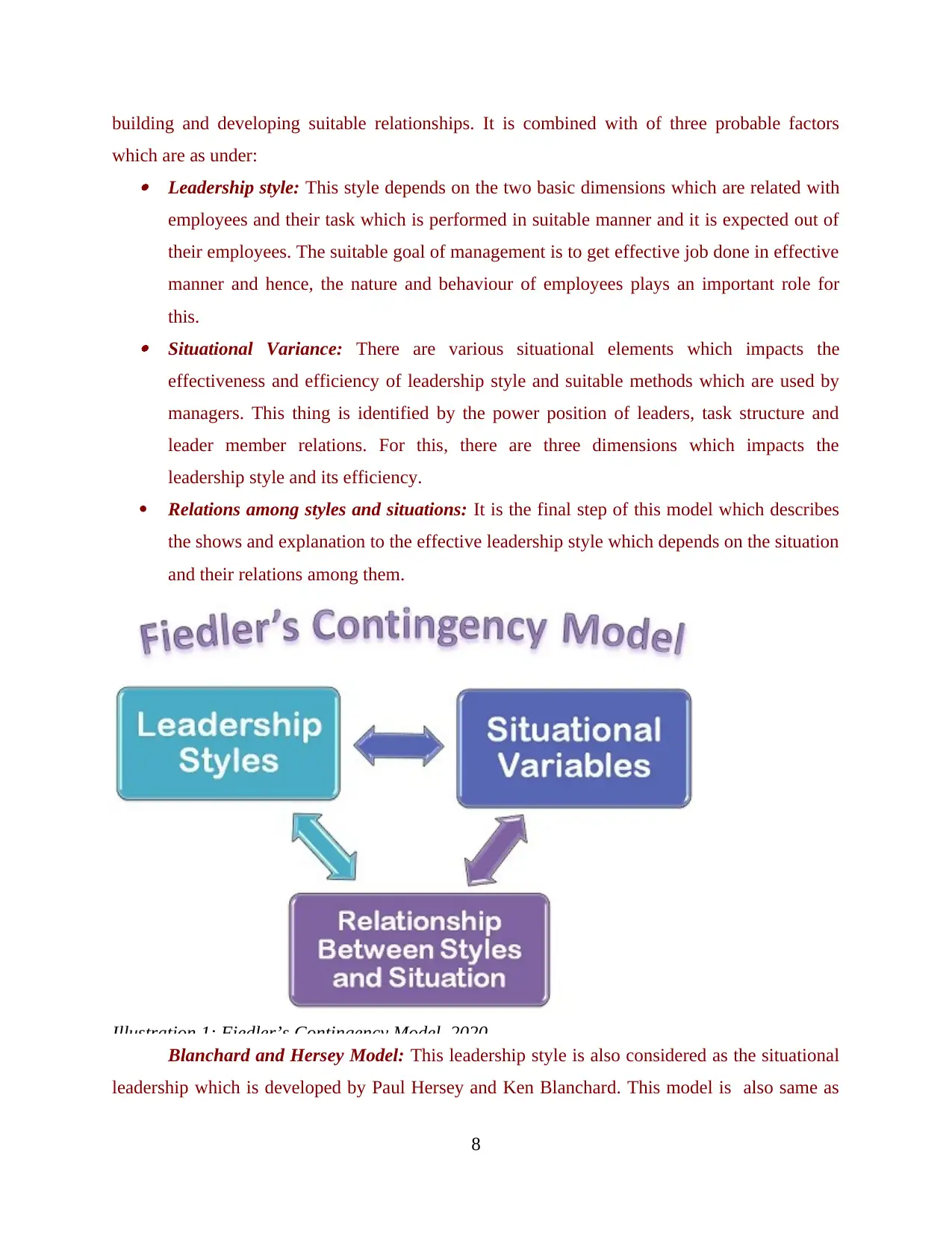
building and developing suitable relationships. It is combined with of three probable factors
which are as under: Leadership style: This style depends on the two basic dimensions which are related with
employees and their task which is performed in suitable manner and it is expected out of
their employees. The suitable goal of management is to get effective job done in effective
manner and hence, the nature and behaviour of employees plays an important role for
this. Situational Variance: There are various situational elements which impacts the
effectiveness and efficiency of leadership style and suitable methods which are used by
managers. This thing is identified by the power position of leaders, task structure and
leader member relations. For this, there are three dimensions which impacts the
leadership style and its efficiency.
Relations among styles and situations: It is the final step of this model which describes
the shows and explanation to the effective leadership style which depends on the situation
and their relations among them.
Illustration 1: Fiedler’s Contingency Model, 2020
Blanchard and Hersey Model: This leadership style is also considered as the situational
leadership which is developed by Paul Hersey and Ken Blanchard. This model is also same as
8
which are as under: Leadership style: This style depends on the two basic dimensions which are related with
employees and their task which is performed in suitable manner and it is expected out of
their employees. The suitable goal of management is to get effective job done in effective
manner and hence, the nature and behaviour of employees plays an important role for
this. Situational Variance: There are various situational elements which impacts the
effectiveness and efficiency of leadership style and suitable methods which are used by
managers. This thing is identified by the power position of leaders, task structure and
leader member relations. For this, there are three dimensions which impacts the
leadership style and its efficiency.
Relations among styles and situations: It is the final step of this model which describes
the shows and explanation to the effective leadership style which depends on the situation
and their relations among them.
Illustration 1: Fiedler’s Contingency Model, 2020
Blanchard and Hersey Model: This leadership style is also considered as the situational
leadership which is developed by Paul Hersey and Ken Blanchard. This model is also same as
8
Paraphrase This Document
Need a fresh take? Get an instant paraphrase of this document with our AI Paraphraser
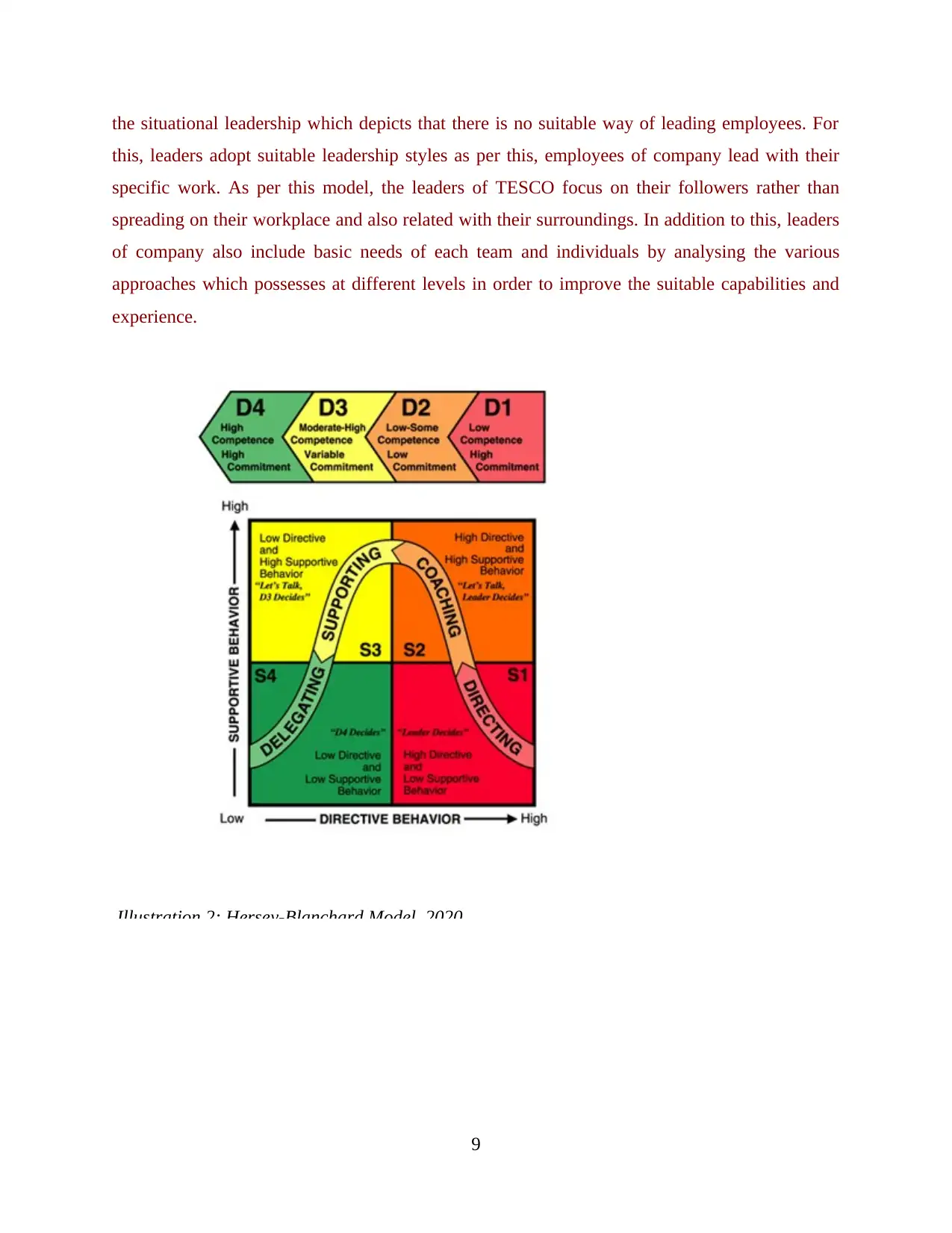
the situational leadership which depicts that there is no suitable way of leading employees. For
this, leaders adopt suitable leadership styles as per this, employees of company lead with their
specific work. As per this model, the leaders of TESCO focus on their followers rather than
spreading on their workplace and also related with their surroundings. In addition to this, leaders
of company also include basic needs of each team and individuals by analysing the various
approaches which possesses at different levels in order to improve the suitable capabilities and
experience.
Illustration 2: Hersey-Blanchard Model, 2020
9
this, leaders adopt suitable leadership styles as per this, employees of company lead with their
specific work. As per this model, the leaders of TESCO focus on their followers rather than
spreading on their workplace and also related with their surroundings. In addition to this, leaders
of company also include basic needs of each team and individuals by analysing the various
approaches which possesses at different levels in order to improve the suitable capabilities and
experience.
Illustration 2: Hersey-Blanchard Model, 2020
9
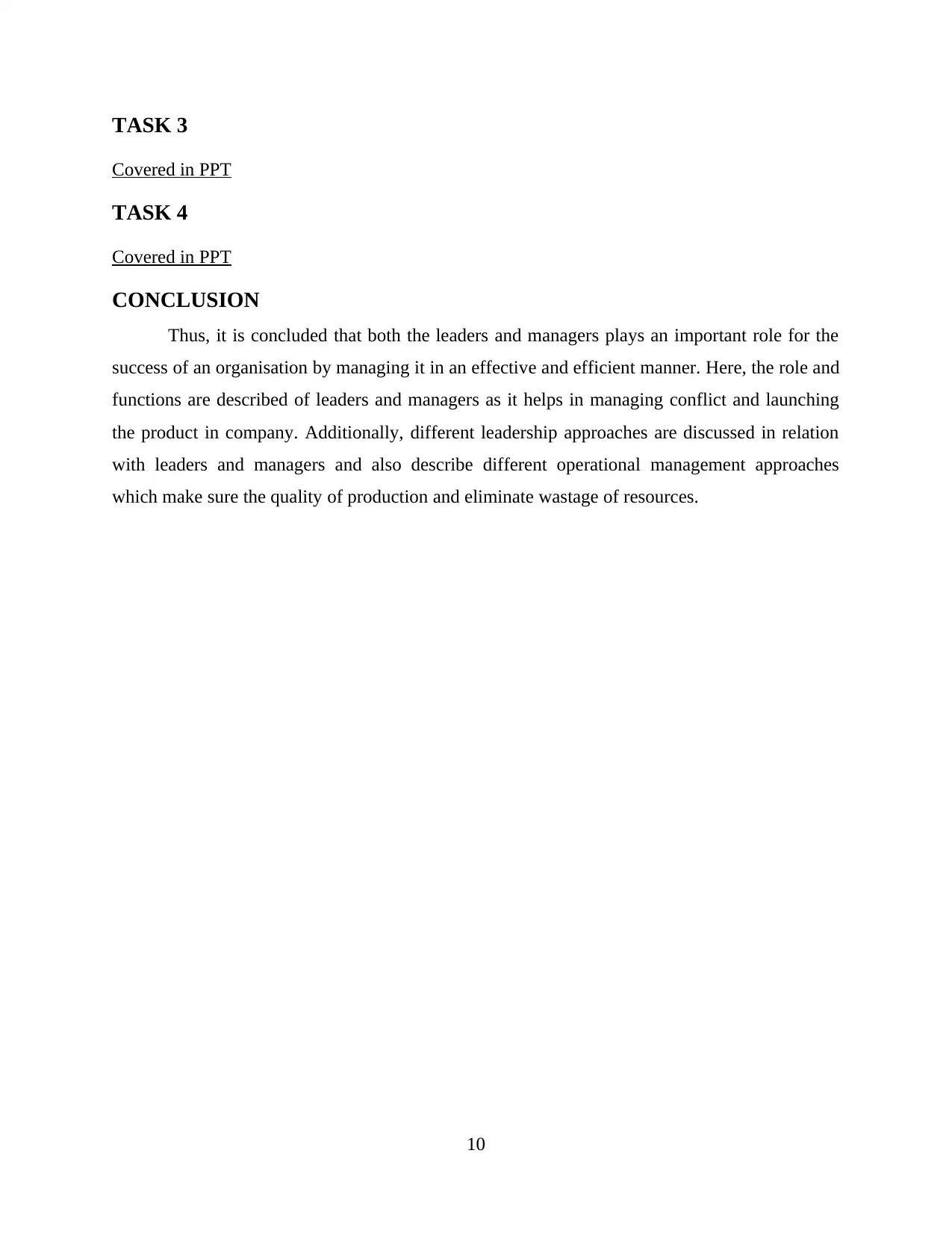
TASK 3
Covered in PPT
TASK 4
Covered in PPT
CONCLUSION
Thus, it is concluded that both the leaders and managers plays an important role for the
success of an organisation by managing it in an effective and efficient manner. Here, the role and
functions are described of leaders and managers as it helps in managing conflict and launching
the product in company. Additionally, different leadership approaches are discussed in relation
with leaders and managers and also describe different operational management approaches
which make sure the quality of production and eliminate wastage of resources.
10
Covered in PPT
TASK 4
Covered in PPT
CONCLUSION
Thus, it is concluded that both the leaders and managers plays an important role for the
success of an organisation by managing it in an effective and efficient manner. Here, the role and
functions are described of leaders and managers as it helps in managing conflict and launching
the product in company. Additionally, different leadership approaches are discussed in relation
with leaders and managers and also describe different operational management approaches
which make sure the quality of production and eliminate wastage of resources.
10
⊘ This is a preview!⊘
Do you want full access?
Subscribe today to unlock all pages.

Trusted by 1+ million students worldwide
1 out of 13
Related Documents
Your All-in-One AI-Powered Toolkit for Academic Success.
+13062052269
info@desklib.com
Available 24*7 on WhatsApp / Email
![[object Object]](/_next/static/media/star-bottom.7253800d.svg)
Unlock your academic potential
Copyright © 2020–2025 A2Z Services. All Rights Reserved. Developed and managed by ZUCOL.





